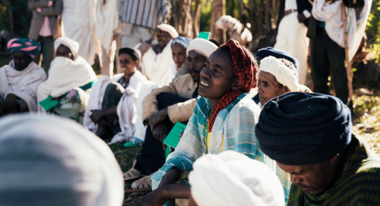Suppy Chains: Traceability and Transparency are Key to Reduce Deforestation
General acceptance is still lacking. But sustainable supply chains require an unprecedented cooperation between very diverse actors - and pilot projects that are turned into established practice.

Almost 90% of the world’s forest loss is driven by the expansion of agriculture, thanks to growing consumer demand for commodities like coffee, cocoa, beef, soy, palm oil and timber. To better understand where and how production is associated with forest loss, we need to better monitor the journey of products from harvest to sale and make supply chains more transparent and products more traceable.
The international community has recognized the urgent need to halt deforestation and the role of agriculture in driving it. Some markets are developing policies that prohibit the sale or importation of products grown on deforested land, while hundreds of consumer goods companies have made zero-deforestation pledges. These policies are urgently needed because a broad uptake of traceability and transparency in supply chains is still missing.
Modern Supply Chains are Complex and Often Opaque
Companies need to identify the origin of a commodity or product to know whether they are contributing to deforestation. This is often difficult because modern supply chains are complex and frequently opaque.
Take the example of a simple chocolate bar: Its key ingredient is cocoa, a raw commodity that can change hands and borders multiple times before it finally reaches a consumer. Most of the world’s cocoa is produced by smallholder farmers in West Africa, is primarily exported to Europe where it is processed and transformed into chocolate products and then distributed to retailers all over the world. Connecting the dots between hundreds or even thousands of actors along a complex global supply chain is a big task. For instance, a multinational company like Unilever sources raw materials from up to 52,000 suppliers.

Even when the information about the origin of products exists, it may not be available to everyone who is responsible to root out deforestation. Retailers and investors need access to information to decide about who they buy from or invest in. Governments and civil society need transparent supply chains to track companies’ compliance with policies and pledges.
There are many solutions to deliver better information on deforestation in supply chains. But despite the rapid progress seen to date, more actions are urgently needed from all groups to reduce forest loss in agricultural and forest supply chains.
Individual companies and platforms have pledged to remove deforestation from supply chains, but currently only 36 percent of the largest companies have commitments and many of them are not systematically monitoring any progress made. Many efforts have been focused on individual supply chains and small pilots. More funding and staff are needed to meet the commitments made by governments to halt and reverse forest loss.
Scaling up Tools and Successful Projects
A broad range of tools shows that traceability and transparency are achievable despite complex challenges. A recent report by the World Resources Institute (WRI) highlights what we can learn from successful projects and accelerate the pace and scope of action. For companies and others to effectively trace deforestation in supply chains, tools and initiatives must meet four key conditions.
1. Aligning stakeholders, harmonizing and standardizing data sharing
Project objectives and data sets with different definitions and metrics make efforts to build collaborative systems cumbersome or even infeasible. Therefore, alignment among supply chain stakeholders is important — including governments in commodity-producing and exporting countries, private sector companies and civil society organizations – as well as close collaboration to ensure that data can be shared and used across different traceability systems. This includes the development of consistent, harmonized definitions, standardized data reporting requirements and formats, and data-sharing strategies with ethical, legal, commercial and technical considerations.
The U.S. government-funded Forest Data Partnership, a consortium led by WRI, aims to address this challenge by harmonizing data from different sources using machine learning to provide supply chain actors with high-quality land use data. Similarly, the GIZ-led Digital Integration of Agricultural Supply Chains Alliance (DIASCA) is working to enable traceability systems in global agricultural supply chains to exchange data by establishing common best practices.
2. A supportive regulatory environment
A supportive regulatory environment is critical for ensuring that data is available and shared among different stakeholders. For example, due diligence requirements and mandatory reporting standards set out by government agencies for companies and financial institutions are powerful tools to increase levels of disclosure, creating broader demand for traceability and transparency, especially where reporting currently remains voluntary.
For example, the UK was one of the major economies to make climate disclosures mandatory for publicly listed companies, using standards from the Task Force on Climate-related Financial Disclosures (TCFD). Its guidance for agriculture, food and forest products companies is to provide key metrics related to the implications of land use change and associated greenhouse gas emissions, which helps companies and the banks that fund them prioritize these chronic risks.
3. Broad-based collaboration to avoid duplication and saving time and investment
As traceability and transparency tools and initiatives proliferate, the risk of duplication increases. For example, several companies could be mapping the same farms. Collaboration is vital to avoid wasting time and investment, especially when different companies often share the same supply base.

It can be challenging for companies to figure out how to collaborate with their competitors. Data confidentiality and commercial sensitivities often hinder data sharing. But it’s essential that companies come together with others in the industry to tackle a shared challenge and coordinate traceability efforts.
For example, private sector actors teamed up with civil society partners to create the Universal Mill List, which mapped close to 2,000 palm oil mills across 26 countries. It is the first global standardized company-accepted list of palm oil mills. Palm oil mills process fresh fruit bunches from oil palm trees. The location of a mill provides a useful estimate of where the palm oil supply is coming from. The list uses a standard process to assemble disparate information into one convenient source of mill data, representing a leap forward in transparency in the palm oil industry.
4. Inclusion of small farmers and investing in equitable solutions
Collective action is also central to support smallholder farmers so they are not left behind in the transition to sustainable commodity production. There are many burdens smallholders have difficulties to absorb. Increased reporting requirements related to due diligence regulations, for example, often lead to higher costs and time investment for smallholders.
In some cases, companies may choose to stop sourcing from small producers to simplify supply chain mapping. In others, producers are asked to absorb the additional cost of providing geolocation data, information supporting risk assessments, and confirmation of land tenure. Designing, maintaining and updating traceability tools as well as training and reporting is also costly.
An equitable cost sharing mechanism is essential to avoid much of the burden falling on producers, including the millions of smallholders that grow coffee, cocoa, rubber and palm oil, among other commodities. This could include price floors or other government controls, certification standards and price guarantees, and commitments from larger companies to pay a minimum price.
A specific example of how collective action can support smallholders is the Cocoa & Forests Initiative (CFI), where the governments of Ghana and Côte d’Ivoire and major cocoa and chocolate companies joined forces to end deforestation and restore forests in these countries. Together, these companies have been working to map smallholder farms, which produce most of the cacao grown in West Africa, to better identify areas at risk of deforestation. The initiative also supports farmers in growing more cocoa on less land — such as by creating agroforestry cocoa plots and distributing cocoa seedlings to farmers. These practices help farmers produce higher yields and increase their incomes by growing other types of crops like wood, fruits and nuts.
Success Requires All Hands on Deck
Realizing sustainable, deforestation-free supply chains will require unprecedented collaboration among many different supply chain actors. Traceability and transparency are not silver-bullets for other challenges such as poverty, lack of secure land tenure and power imbalances in supply chains that contribute to the destruction of forests. But increased access to information can lead to better decision-making in supply chains to avoid forest loss. More effective monitoring of the impact of commodity supply chains on forests can also be useful for civil society organizations to hold companies accountable.
Each sector has a role to play in advancing traceability and transparency:
Governments should create legal requirements for national standards and assurance systems. They can also provide official data sets on land use, rural property registration, land titling and trade. With this information, companies can verify, if their suppliers have clear tenure, and government agencies can avoid to issue land concessions in protected areas.
The private sector should make sure that costs incurred by traceability and transparency are equitably shared to address specific needs of smallholder farmers. Companies could, for example, develop data collection systems that take smallholder interests into account, empowering them with easy access to their own data like production and yield and sale prices.
Civil societyorganizations should provide technical expertise and ensure that costs do not limit access to tools and platforms, especially among vulnerable farmers. They should put in place safeguards to protect privacy in a way that encourages data sharing.





